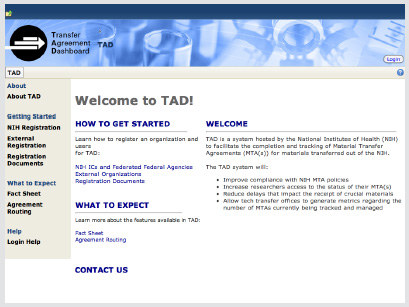News You Can Use
New Web-Based Material Transfer Agreements System

The home page of the Transfer Agreement Dashboard for the new Web-based Material Transfer Agreement System: https://techtransferagreements.nih.gov.
Got materials? Before you share them, document them. NIH Material Transfer Agreements (MTAs) are agreements that govern the transfer of tangible research materials between two organizations when the recipient intends to use the material for his or her own research purposes.
Some examples of materials include unique reagents, cell lines, plasmids, chemical compounds, and vectors. MTAs also may be used for other types of research materials and resources, such as animal models and even some types of software.
Accurate data on NIH research materials transferred to other researchers has been very difficult to obtain across the NIH. But we need to be able to account—simply, quickly, and accurately—for all scientists’ materials being shared. We need to ensure that there is appropriate documentation for all transferred material, too.
So, after many years of planning and with input from our scientists for a simple e-system, we recently deployed a centralized Web-based MTA system, called the Transfer Agreement Dashboard (TAD).
Material transfers between investigators are essential to the continued advancement of scientific research, and I believe the new NIH system will facilitate transfers, not hinder them. For starters, building on input from many NIH research and tech-transfer staff, the new system will be intuitive, less time-consuming, and nearly paperless. More important, the standardized workflow helps ensure compliance with requirements.
Initially, the TAD system will handle transfers of outbound NIH materials. Eventually the system will process inbound transfers of research materials to NIH researchers, allowing us to more easily access vital materials generated by the external research community and vice versa. Also, the TAD system will provide key metrics to help us better highlight NIH research and resources to Congress and the public.
The new enterprise-wide TAD system debuted in mid-October. Someone from your institute or center (IC) will be in touch to instruct you on its use. The TAD development team, along with CIT and other NIH ICs, offered demos of the new system at an exhibitor booth at the NIH Research Festival in October.
For more information, visit https://techtransferagreements.nih.gov or e-mail NIHTADSupport@mail.nih.gov.
Benefits of the Web-Based MTA
More than 6,000 intramural researchers at NIH laboratories along with 325,000 scientists and research personnel at more than 3,000 institutions nationwide drive the research and discovery process. Material transfers between investigators, laboratories, and organizations are essential to the continued advancement of scientific research.
Material Transfer Agreements (MTAs) govern the transfer of tangible research materials between organizations when the recipient intends to use the material for his or her own research purposes. The MTA defines the rights of the provider and the recipient with respect to the materials and any derivatives.
The new Web-based MTA system:
Is less time consuming
- Expect shorter turn-around time related to materials requests.
- Spend less time dealing with MTAs and more time on research.
- Electronic signatures enables fast, paperless execution of MTAs.
Is intuitive and easy
- Standardized workflow makes compliance with requirements easy.
- Key steps are less likely to be omitted.
- Online forms have built-in validation and provide instant notification of possible compliance or accuracy issues.
Provides better access to MTA data
- Have 24/7 access to the status of in-process MTAs.
- Track the number and types of outbound MTAs at an enterprise level across ICs.
Lets researchers leverage lessons learned
- Quickly search for MTAs that have been successfully implemented.
- View comments and history of the full transaction process.
This page was last updated on Monday, May 2, 2022
